How to Make Espresso Machine Coffee
Espresso machines can make an excellent cup of coffee, however it requires some more set-up and upkeep than a traditional drip coffee maker. You'll also need to grind and tamp the beans yourself.
Pressure is the key to making espresso. Here's how an espresso machine operates: a heating device heats water to the ideal temperature before forcing it through the grounds before pouring out the spouts.
Temperature
Espresso is created by forcing hot water, under pressure, through finely ground coffee beans. The temperature of the water is crucial to the quality of the final shot. Insufficient temperatures can result in the inadequate extraction of essential flavor compounds. High temperatures can cause over extraction, which may result in a bitter or burned taste.
The ideal temperature range for espresso is 195 to 205 degrees F. This temperature can be achieved by using a group head designed to keep stability and a consistent temperature throughout the brewing cycle. The E61 is the most sought-after group head since it offers a combination of the ability to stabilize temperature, pre-infusion and lever control.
It is important to take into account the temperature when you adjust your espresso machine for different roasts or brew ratios. This will affect the extraction yield and the crema. The ideal temperature will depend on the specific roast and bean, but the general rule is that lighter roasts and greater brew ratios require higher temperatures than dark roasts and lower ratios of brew. A reliable thermocouple is essential for maintaining the same temperature.
Pressure
In the process of brewing, espresso machine coffee is pressure-pushed through finely ground and tamped grounds. This triggers chemical reactions that extract flavors, oils, and other soluble components. The beverage produced is usually richer and more flavorful.
The ideal espresso machine pressure should be nine bar, which is equivalent to sea-level pressure. This is due to the fact that it's at this level that the espresso bean's soluble compounds are the easiest to extract.
However, some espresso machines may advertise 15 or even 20 bars of pressure. These machines might be able to attain these pressure levels however, they might not be able to maintain them throughout the extraction.

One bar of pressure equals to 32 pounds per square inch (PSI) of a car's tire. It's also four times the amount of pressure that a professional cyclist uses when pumping up their bike tires. Every serious home barista needs to be able to control the pressure of their espresso machine to produce consistent espressos.
Water
Water is an essential component in a great cup of espresso. The right water can help your beans extract their full potential. However, the wrong water can cause problems like clogged pipes or even damage to your expensive espresso machine.
The best choice is a natural spring water that is rich in minerals that will ensure the best espresso extraction. This water will enhance the flavor of your espresso without the chalky mineral trace that is found in tap or bottled waters. This is an excellent alternative to distilled water or reverse osmosis, which could be too purified and cause taste issues.
But, you shouldn't use a water filter that removes excessive minerals from your tap water, because this could cause flavor and extraction issues. A great option is to purchase an instrument for testing water, which will give you the local average hardness. This information can be used to determine the correct filtration system to your espresso machine.
Beans
Most coffee lovers tend to be involved in the entire process of making espresso. They are obsessed with a variety of variables, such as temperature, pressure of water beans, milk viscosity, and many other variables. If one of these variables is not working, even a little the whole shot may taste bad.
The most important element when it comes to espresso is the beans used. Many believe that only certain kinds are suitable for espresso. While some beans are better than others for specific purposes, any roasted bean can be used for espresso. The main difference between espresso beans and regular coffee beans is that espresso beans are roasted more, tipycally past the second crack which gives them their darker appearance and makes them more soluble in water.
The best beans for espresso are typically medium roasted or dark roasted, which give the shots that distinctive richness and vigor. Light roasted beans can also be used to make excellent espresso, especially when they are ground for ease of use in an espresso maker.
Milk
Espresso and milk is a timeless combination. The combination of espresso and milk is a classic. It does not only improve energy levels, but it also balances the bitterness of espresso. This is one of the most delicious culinary pairings!
If you choose to buy an espresso machine that is able to make cappuccino or lattes, be sure to examine how easy it is to use. Many of the best machines come with a jug of hot or cold coffee and a steam wand. They also have a portafilter for pulling the shot. Some models come with a built-in grinder or tamper.
The steam wand needs to be cleaned prior to using it for the first time each day (or after every cup of espresso) to eliminate any water that has condensed. The process takes only 30 seconds, but it is essential to keep your machine running smoothly. Inability to purge could result in an unpleasant taste or the build-up of bacteria that may alter the flavor and aroma of your drinks. It's not difficult to do and should be part of your regular maintenance routine.
